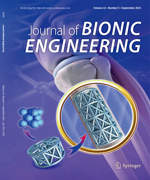Developing efficient walking gaits for quadruped robots has intrigued investigators for years. Trot gait, as a fast locomotion gait, has been widely used in robot control. This paper follows the idea of the six determinants of gait and designs a trot gait for a parallel-leg quadruped robot, Baby Elephant. The walking period and step length are set as constants to maintain a relatively fast speed while changing different foot trajectories to test walking quality. Experiments show that kicking leg back improves body stability. Then, a steady and smooth trot gait is designed. Furthermore, inspired by Central Pattern Generators (CPG), a series CPG model is proposed to achieve robust and dynamic trot gait. It is generally believed that CPG is capable of producing rhythmic movements, such as swimming, walking, and flying, even when isolated from brain and sensory inputs. The proposed CPG model, inspired by the series concept, can automatically learn the previous well-designed trot gait and reproduce it, and has the ability to change its walking frequency online as well. Experiments are done in real world to verify this method.

 Table of Content
Table of Content
 Table of Content
Table of Content